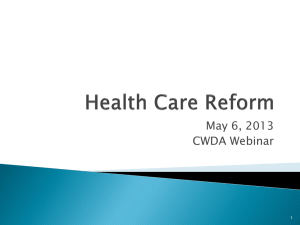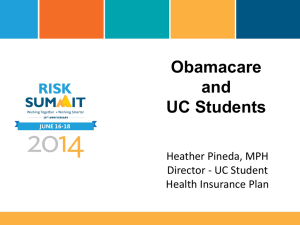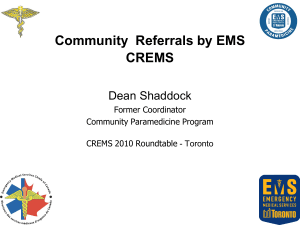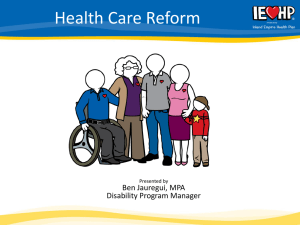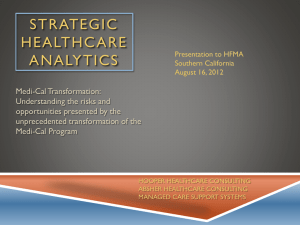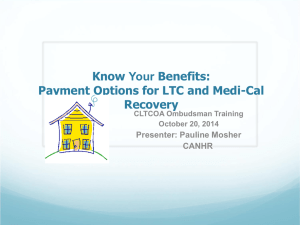CAA Impact of HCR Slides 9-19-12
advertisement
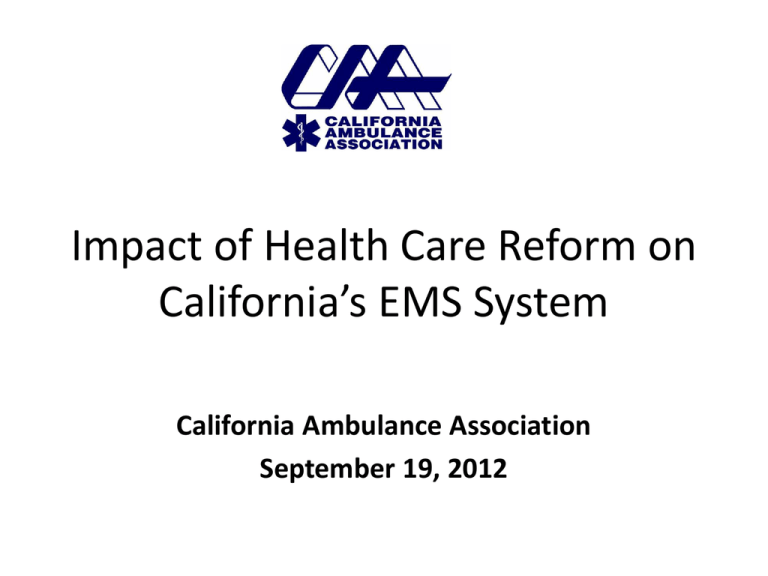
Impact of Health Care Reform on California’s EMS System California Ambulance Association September 19, 2012 Impact of Health Care Reform on California’s EMS System • What is the Cost of Readiness? • Patient care revenues provide major support of the statewide EMS system • Impact of Affordable Care Act on EMS • Principles for EMS Reforms • Four Recommendations Patient Protection and Affordable Care Act signed into law March 23, 2010 Healthcare Reform Highlights 1. Near universal coverage causes sustained charity care 2. Medi-Cal expansion and severe Medi-Cal underfunding 3. Access to care threatened by flawed definition applied to EMS 4. Opportunities for innovation 5. New health information technology requirements 6. Expanded fraud/abuse prevention Cost of Readiness Cost of Readiness Medicare Ambulance Fee Schedule relative value units: BLS-NE BLS-E ALS-NE ALS-E ALS-2 SCT 1.00 1.60 1.20 1.90 2.75 3.25 Cost of Readiness Emergency service is an average of 66% more costly than non-emergency service (GAO) Cost of Readiness is underfunded by Medicare and Medi-Cal Cost of Readiness IOM Definition: “Direct costs of each emergency response as well as the readiness costs associated with maintaining the capability to respond quickly, 24/7” “Costs that are not adequately reimbursed by Medicare” Patient Care Revenues Average Payer Mix - Transports Other Medi-Cal 8.5% Commercial Insurance 21.0% 17.7% 17.9% Private Pay 34.9% Medicare Hobbs, Ong 2006 Medicare + Medi-Cal + Private Pay = 73% Average Payer Mix - Revenue Comparison of Cost to Reimbursement Per Ambulance Transport $1,400 $1,200 $1,000 $800 $600 $400 $200 $- Medi-Cal Private Pay Medicare Commercial $150 $233 $426 Insurance $1274 Hobbs, Ong 2006 $300 Million Charity Care • 18% of patients are uninsured • Estimated $300 million annually in charity care delivered by statewide 9-1-1 providers • ACA and Medi-Cal expansion reduces, does not eliminate, uninsured Counties retain responsibility for indigent care (Lomita decision), however, design EMS systems to shift this responsibility to commercial insurers (charges to commercial insurers are 5-8 times higher than Medi-Cal) and patients (out-of-pocket co-pays/deductibles) via local rate regulation Near Universal Coverage of the Uninsured • Medi-Cal predicted to grow by 27% – 2 million over 9 years • Currently 7 million CA Uninsured: – 2 million enroll in Medi-Cal – 2-4 million obtain private coverage – 1-2 million remain uninsured • “Implement and improve on aspects of ACA” CA Joint Hearing on Federal HCR Senate & Assembly Health Committee Medi-Cal Expenditures Medical Transportation Air $13.6 $43.8 Gurney Van & Wheel Chair Ground $105.2 Total Medi-Cal Expenditures (Medical Transportation) = $162.6 million Medi-Cal Expenditures Statewide $0.1625 Physician Skilled Nursing Facility Medical Trans including Ground Ambulance (.15% of total expenditures) $1.6 $5.0 $13.5 Managed Care $10.7 Hospital Medi-Cal Total Expenditures = $28.9 billion Medi-Cal Severely Underfunds EMS Medi-Cal covers one quarter of the average cost per transport Medi-Cal Severely Underfunds EMS • 90% of Medi-Cal transports are 9-1-1 calls (10% inter-facility transports) • Uninsured patients pay more out-of-pocket ($233) than Medi-Cal ($150) • CA Medi-Cal rates rank 41st in US • Medi-Cal payments cover just one quarter of the average cost of service Challenges and Opportunities of Affordable Care Act Impact of Health Care Reform? 4) Shift from comm insurance to uninsured or Medi-Cal 8.5% 8.5% Other Other 17.7% Comm Insurance Medicare 21.0% Medi-Cal Private Pay 17.9% 15.2% 26.0% Medi-Cal Comm Insurance Private Pay Medicare 15.4% 34.9% 34.9% 3) Increase in co-pays & deductibles 1) Increase in Medi-Cal Current Post ACA 2) Fewer uninsured Potential Impacts - EMS Systems Shrinking Patient Care Revenues • • • • • • Number of Medi-Cal transports grows with more patients covered by lowest source of reimb Loss of cost shift to commercial insurers Continued shifts in payer mix; potential second wave of uninsured as businesses drop coverage New CMS-approved access to care standard allows further Medi-Cal rate reductions “Near universal coverage” guarantees many still uninsured (1-2 million) New pressures associated with county responsibility for indigent care; county rate regulation Broader Reforms Eventually Reach EMS • • • • New health information technology requirements Value-based purchasing (or pay-for-performance) eventually applies to EMS Comparative effectiveness research impacts system design Too early to know impacts of ACOs and shared savings programs Potential Need for EMS System Redesign • • • Triple Aim: Better health, better quality, lower cost Community paramedic programs grow EMS becomes more integrated with the rest of health care Potential Impacts - EMS Patients Lowered quality of care • Prevent and slow innovative treatments, drugs and technologies; Reductions in training, supply and capital expenditures; Deferred equipment purchases, lengthened replacement schedules Decreased access to care • Longer paramedic response times, reduced paramedic response capacity, fewer staffed paramedic ambulances; Fewer “unit hours,” closed or “browned out” fire/ambulance stations Reduced supply of care • Reduced services in hard hit communities with vulnerable populations: suburban and rural areas, depressed economic areas, and areas with high numbers of uninsured/Medi-Cal patients Barriers to access to care • Penalizes 9-1-1 patients covered by commercial insurance with high co-pays and deductibles; high out-of-pocket expenses create a personal financial consequence for dialing 9-1-1 Establish a baseline assessment and ongoing monitoring of changes in system revenues and impact on quality, access and supply Potential Impacts - EMS Patients Alternatively , innovation and system redesign could achieve: • Improved quality of care • Increased access and supply of the right care • More coordinated care • Increased transparency and accountability Establish a baseline assessment and ongoing monitoring of changes in system revenues and impact on quality, access and supply Principles for EMS Reform EMS Principles for Health Care Reform 1. Engage all stakeholders 2. Preserve prudent layperson standard for emergency response 3. Assure minimum benefit packages include EMS 4. Improve coordination, expand regionalization, increase transparency/accountability 5. Advance quality initiatives and performance principles California Ambulance Association EMS Principles for Health Care Reform 6. Align the incentives of providers, patients and payers 7. Assure adequate funding of cost of readiness 8. Recognize the value of injury and illness prevention 9. New focus on evidence base: achieving better outcomes and lower costs Recommendations Recommendations 1. Pass legislation to establish supplemental Medi-Cal payments for ground ambulance providers 2. Establish county-based models to fund charity care (intergovernmental transfers, IGT) 3. Establish an access to care definition specifically for emergency medical services 4. Continue implementation of uniform coding system for MediCal (HCPCS codes) California Ambulance Association Thank You Recommendation #1: Establish Supplemental Medi-Cal Payments for Ground Ambulance • History of Efforts to Increase Medi-Cal Rates – – – – – – – – Last rate increase in 98/99; over 30% increase in costs since Multiple rate reductions since 98/99 Medi-Cal rate increase legislation last three sessions passed policy committees Proposal for QAF/Provider Tax created losers (2009-2010) Proposal to expand CPE rejected (2011) Proposal for Supplemental Payments same as air ambulance delayed (2012) Successful injunction to stop another 10% rate cut (2012) Legal challenge in federal court (pending) • Goal for 2013 – Pass legislation establishing supplemental payments to ambulance providers via fee increase Recommendation #2: Establish county-based models to fund charity care to indigents • EMS-specific Section 1115 Waiver Demonstration Request – for federally-matched supplemental payments associated with the uncompensated care costs attributable to the uninsured • State Plan Amendment Request for an EMS-specific Intergovernmental Transfer (IGT) Program – for federally-matched supplemental payments or rate increase associated with the uncompensated care costs attributable to Medi-Cal patients • CAA Letter to EMSAAC (March 2012) – Identify new financial models to fund EMS uncompensated care burden; transition away from shifting the cost of this care to commercial insurers – Recognize the responsibilities of counties to fund indigent care (i.e., Lomita Decision) – Include counties as strategic partners and include all provider types, public and private • Goal for 2013 – Establish county-based pilots and replicate successful models Recommendation #3: Establish access to care standard for EMS • Medi-Cal rate reductions now based upon flawed access to care standard approved by CMS - Section 1902(a)(30)(A) – Baseline assessment and monitoring plan not based upon reality of emergency service – Assumes emergency provider can deny service to patients; analysis mixed with services like dentistry – Ambulance data mixed with liter van and wheel chair – Emergency service mixed with non-emergency service • CMS-approved policy creates path for further rate cuts • Stakeholder recommendations: – Form stakeholder workgroup – Emergency-specific access to care standard: Lowered quality of care; Decreased access to care; Reduced supply of care; Barriers to access to care • Goal for 2013 – Establish EMS-specific access to care definition and standard Recommendation #4: Continue implementation of HCPCS codes • Federal law requires uniform system of claims processing • Continue implementation of Ambulance HCPCS Codes: – – – – Move from 20 old “x codes” to 9 “HCPCS codes” Bundle all add-on charges to match Medicare Crosswalk Implementation • Needed to prepare for health information technology enhancements • Goal for 2012/2013 – Continue implementation of uniform coding system for Medi-Cal (HCPCS codes) References • Centers for Medicare and Medicaid Services (CMS), “2008 Physician/Supplier Procedure Summary Master File,” for transport counts by locality. • Electronic Data Systems (EDS), "CY 08 Medi-Cal Ambulance Utilization Report," fee-for-service claims filed from 1/01/08 - 12/31/08. • Hobbs, Ong & Associates, Inc., "Industry Performance Survey," California Ambulance Association, September 2006. • U.S. Government Accountability Office, "Ambulance Providers: Costs and Expected Medicare Margins Vary Greatly," Report to Congressional Committees, GAO-07-383, May 2007. • National EMS Advisory Council (NEMSAC), “EMS Makes a Difference,” Position Statement, www.ems.gov, 2009. • Institutes of Medicine (IOM), “Future of Emergency Care in the US: EMS at the Crossroads,” National Academy of Sciences, www.iom.edu, 2007.


